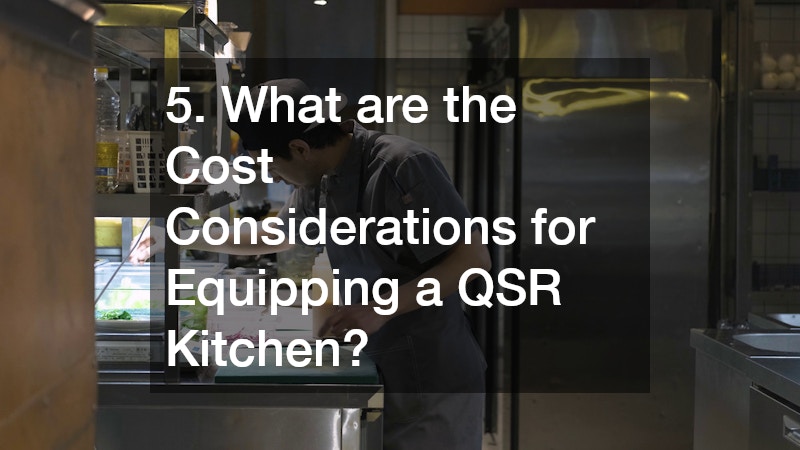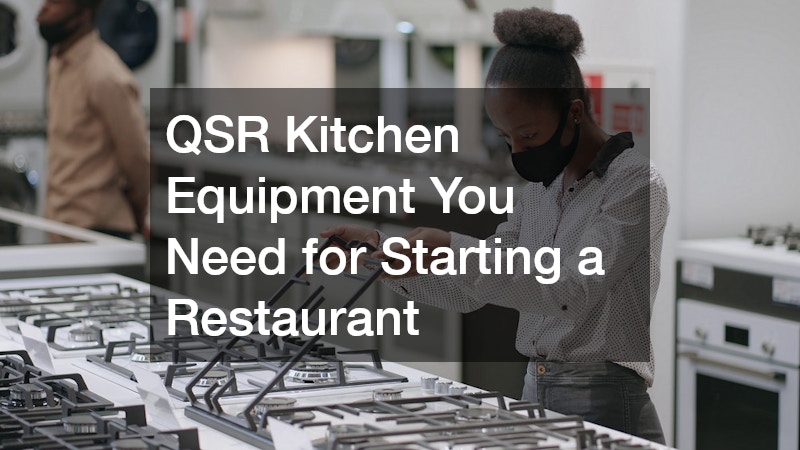
Starting a restaurant involves numerous decisions, one of which is selecting the appropriate kitchen equipment to ensure efficiency and quality in a Quick Service Restaurant (QSR) setting. This article will guide you through the essential QSR kitchen equipment you need for a successful restaurant launch.
1. What are the Essential Cooking Equipment for a QSR?
A. Choosing the Right Ovens and Ranges
Choosing the right ovens and ranges is crucial for a QSR, as these appliances serve as the backbone for most cooking tasks. High-demand environments require efficient, reliable ovens and ranges that can handle varied menus and busy service times.
Convection ovens are commonly used for their ability to evenly cook food, while standard ranges provide versatility for stovetop cooking. The decision often depends on the restaurant’s specific culinary focus and the volume of food preparation needed.
For specialized cooking methods, combination ovens offer a blend of steaming and convection cooking, providing nuanced preparation capabilities. Induction ranges are gaining popularity for their energy efficiency and precise temperature control, making them a smart choice for modern QSR kitchens.
B. The Importance of Grills and Fryers
Grills and fryers play a pivotal role in QSR kitchens, offering the means to prepare staple items like burgers, fried chicken, and more. Ensuring these pieces of equipment are high-capacity and easy-to-clean can markedly impact kitchen efficiency.
Flat-top grills provide a versatile cooking surface ideal for a variety of foods, while charbroilers offer the distinctive flavor profile associated with grilled meat. When choosing a fryer, consider factors such as oil capacity, heating time, and available space in the kitchen.
The choice between open and pressure fryers may depend on the desired speed of cooking and food texture. Fryers with built-in filtration systems not only maintain oil quality but also reduce operating costs by extending the oil’s lifespan.
2. How to Select the Best Refrigeration Solutions?
A. Commercial Refrigerators and Freezers
Commercial refrigeration solutions are vital for food safety and efficiency, ensuring stored items remain fresh and safe to consume. Establishments should choose refrigerators and freezers based on space availability and storage needs.
Reach-in refrigerators offer easy access to frequently used ingredients, while walk-in units provide substantial storage and maintain consistent low temperatures for larger volume preservation. Energy efficiency is an important consideration to minimize operational costs and environmental impact.
Modular refrigeration systems also offer flexibility, allowing owners to tailor units to the kitchen’s specific layout and refrigeration requirements. By selecting the right refrigeration, QSR operators can prevent spoilage and sustain seamless kitchen operations.
B. Proper Storage for Ingredients
Proper storage for ingredients directly impacts the quality and safety of food served in a QSR. The implementation of organized, transparent storage solutions allows for easier inventory management and reduced spoilage.
Shelving units should be strategically placed for efficient workflow, maintaining a clear separation between raw and cooked food to prevent cross-contamination. Utilizing airtight containers further preserves the freshness and flavor of key ingredients.
Labeling stored items with dates and details is an essential practice for inventory turnover. This system also supports compliance with health regulations, ensuring all products are used within their safe consumption period.
3. What Specialty Equipment is Beneficial?
A. Blenders and Food Processors
Blenders and food processors are essential in the preparation of sauces, soups, and smoothies, enhancing the speed and consistency of food preparation. High-performance equipment can handle larger volumes, catering to the fast-paced nature of QSRs.
Many models offer variable speed settings and powerful motors that ensure smooth blending, even with tough ingredients. Additionally, some food processors come with multiple attachments, further expanding their utility.
B. Slicers and Peelers
Specialized equipment like slicers and peelers can significantly enhance kitchen efficiency. These tools enable chefs to achieve uniform cuts and speed up the prep process, which is invaluable during peak service times.
Slicers are particularly useful for meats and cheeses, allowing for precise control over thickness and consistency. Peelers, meanwhile, automate the laborious task of peeling vegetables and fruits, saving time and reducing waste.
4. How to Ensure Safety and Compliance in Kitchen Equipment?
A. Sanitization Tools and Equipment
Maintaining cleanliness in a QSR kitchen is crucial for compliance with health and safety regulations. Proper sanitization tools help prevent foodborne illnesses and promote a safe workspace for kitchen staff.
Automated dishwashers and sanitizers are fundamental, providing consistent, high-temperature cleaning to eliminate bacteria and contaminants. Hand sanitizing stations should be strategically placed to reinforce hygienic practices among the staff.
B. Fire Safety and Ventilation
Ensuring proper fire safety and ventilation in the kitchen is critical to creating a secure, compliant environment. Fire suppression systems should be installed over cooking surfaces to mitigate potential fire hazards.
Regular maintenance checks and staff training on emergency procedures are mandatory for effective fire safety. Additionally, quality ventilation systems reduce smoke and odors, improving air quality and comfort in the kitchen.
5. What are the Cost Considerations for Equipping a QSR Kitchen?
A. Budgeting for High-Quality Essentials
The cost of equipping a QSR kitchen can be substantial, necessitating careful budgeting to balance quality and financial constraints. Investing in high-quality kitchen essentials often results in long-term savings through increased durability and performance.
Analyzing the specific needs of your operation can guide you towards making informed purchasing decisions that prioritize essential equipment over superfluous options. Establishing a solid budget plan helps in allocating resources efficiently and preventing overspending.
B. Financing and Leasing Options
Considering financing or leasing equipment can be beneficial for managing the upfront costs of kitchen equipment. These options can ease cash flow, allowing businesses to equip their kitchens with quality appliances without substantial initial investment.
Financial institutions offer various payment plans tailored to accommodate the differing needs of businesses, providing some relief during initial setup phases. Leasing allows for equipment upgrades, keeping the kitchen up-to-date with technological advancements.




